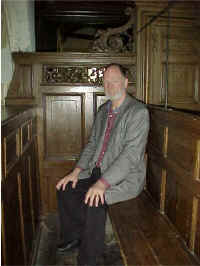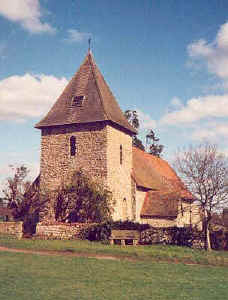West Peckham, Kent, England
St. Dunstan's Church
Ancient parish. Original registers from 1561.
Location: On Church Road off
Mereworth Road, about a mile from the Intersection of the
B2016, the A228, and the A26.
National Grid Coordinates: TQ
644 526
A feature of considerable interest north of
the chancel is the private pew (pictured at the right). This was originally a side chapel and was
founded as a chantry by Sir John Culpeper7a. (A
chantry is an endowment for the chanting of masses,
generally for the founder.) The license for the chantry
reads: |

Warren Culpepper in the private pew at St. Dunstan's, Oct. 1999 |
Henry IV, on the second of March 1408-9, granted
license to John Culpeper, one of the judges of the common bench,
to found a chantry of one chaplain to celebrate divine service
daily in the Church of West Peckham for the good estate of the
King and his consort, Joan, Queen of England, the said John
Culpeper and his wife Katherine, and for their souls after
death, also for the King's father, John, late Duke of Lancaster
and his wife Blanche, the King's mother, and other progenitors
of the King, the parents of John Culpeper and his wife, and
Walter Culpeper; and to grant in mortmain to the chaplain after
inquisition, lands and rents not held in chief to the value of
£10 yearly, and for him and his heirs in to present to the
chantry at vacancies.
|

St. Dunstan's Church, West Peckham |
Sir John and his wife were both buried in
the chantry he had founded. On the north wall, just below
the monument to Leonard Bartholomew and his wife, can be
seen portions of the canopies of tombs which are very
probably those of the founder and his wife.
The brass rubbing to be seen in the pew is
of a brass effigy of Lady Elizabeth Culpeper on the top of
the altar tomb at the northeast corner of the chancel. The
effigy of her husband, Sir William Culpeper, the son of the
founder of the chantry, is missing. A brass plate on the
tomb wrongly records the date of Sir William's death as
1417. In fact, he died in 1457.
The chantry chapel was suppressed in 1548, but no
possession of it was retained by the owners of Oxen Hoath Manor,
and, at some time in the middle of the next century, the existing
vault and pew were constructed. A raised vault and tomb, four feet
high, was erected in the western portion of it, entirely blocking
up the entrance on the north side. Access was then made possible
by making a doorway in the eastern end of the chapel where the
altar of the chantry chapel would have been. A square pew, with
seating for ten people, was then erected on the top of the raised
tomb at the western chancel, the arch cut away and a plastered
beam placed across the top of it. Steps were made to lead from the
pew to the outside door, and also down into the chancel... |
For many generations the owners of Oxen Hoath were
interred in this vault, the last interment being that of the widow
of Sir William Geary, the second baronet. When Sir Borlace Miller
died in 1714 without issue, the estate passed to his sister, who
was married to Leonard Bartholomew. In 1757 the last of the
Bartholomews died without issue, and by his will left the estate
to the son of Admiral Sir Francis Geary. The Geary family remained
in possession of Oxen Hoath until the death of Sir William, the
fifth baronet, in 1944. Although the last interment in the vault
was in 1871, the pew remained in use until the death of Sir
William...
(Source: Church Pamphlet, undated,
obtained at church in October 1999) |
West Peckham Manor
See
Dukes Place
|
West Peckham
Location: Off the A26, 12 miles NNW of
Goudhurst, and 8 miles WSW of Maidstone.
National Grid Coordinates: TQ
645 525
West Peckham is a quiet village in the
midst of smiling orchard country, with fields surrounding the
village and no main roads running through the most attractive
parts of it. The parish church of St. Dunstan lies down a narrow
lane and stands opposite the village green. The church predates
the Norman Conquest and there are some fascinating wooden carvings
behind the altar - although these seem to be of a later date. West
Peckham is on the Wealdway and Greensand Way footpaths, which
trace their way across the higher ground in the vicinity. Another
footpath, leading west from the village, passes the edge of Oxen Hoath, a large mansion and estate built by the Culpeper
family. Further along the path, from a stone bridge by a small
lake, there is a good view of the house, which commands excellent
views of the Medway Valley and the Weald. (Source: Connolly, Sean,
Hidden Places of Kent, 1998, pages 85-86)
1831 Topographical Dictionary
PECKHAM (WEST), a parish in the hundred of LITTLEFIELD, lathe of
AYLESFORD, county of KENT, 6 miles (N.E.) from Tunbridge,
containing, with Oxen Hoath, 498 inhabitants... The church, dedicated to St.
Dunstan, is a small building, with a tower surmounted by a spire,
situated on an eminence nearly in the center of the parish... A preceptory of Knights Hospitallers was founded
here, in 1408, by John Culpeper7a, one of the
Justices of the Common Pleas. |
Also See: Oxen Hoath, Dukes
Place, Old Soar, Hadlow
and Wrotham
Last Revised:
02 Jan 2015 |
|